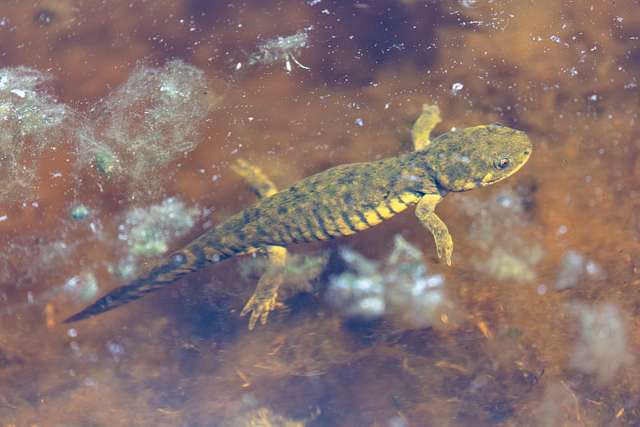By Courtney Collins
Western tiger salamanders (Ambystoma mavortium) are found from inland British Columbia to western Manitoba and are divided into two populations: the Southern Mountain population occurring in British Columbia and the Prairie/Boreal population occurring in Alberta, Saskatchewan, and Manitoba.1 In Alberta, there are two subspecies: the blotched tiger salamander and grey tiger salamander.2 Unfortunately, the Southern Mountain population is currently listed as endangered, and the Prairie/Boreal population is listed as special concern.3
This species is one of the largest in North America, reaching 20-30 centimeters in length, with a green-brownish body and dark stripes and/or spots, reminiscent of a tiger.4 These salamanders breed in standing or slow-moving waterbodies including wetlands, ponds, or lakes without fish (which are predators of salamanders). They live in a variety of environments with soil suitable for burrowing near waterbodies suitable for breeding.5

During the winter, western tiger salamanders burrow in terrestrial habitat and once spring arrives, they migrate several hundred metres between their terrestrial and breeding habitats, with the opposite migration happening in autumn.6,7 Spring migration generally happens once waterbodies are ice-free, after raining, and during the night.8 Unfortunately, the habitats this species requires are often separated by roadways – making migration quite dangerous, and sometimes fatal. A statistic notes that vehicles kill 40-100 percent of salamanders during migration in some places.9 Additionally, this salamander is at risk from other impacts, including further habitat fragmentation (where habitat is discontinuous, often due to human impacts like roadways), fish stocking in waterbodies that could be used by this species, and diseases that can decimate populations.1

There are a variety of conservation measures that are in place or being worked on. More information can be found in the Species at Risk Act, Management Plan for the Western Tiger Salamander here. You may even find opportunities to help this amazing species in your area!
References
- COSEWIC ,“Assessment and Status Report on the Western Tiger Salamander Ambystoma mavortium in Canada”, Committee on the Status of Endangered Wildlife in Canada, 2012, https://www.sararegistry.gc.ca/virtual_sara/files/cosewic/sr_w_tiger_salaman_tigree_1113_e.pdf
- Alberta Volunteer Amphibian Monitoring Program, “(Western) Tiger Salamander”, Alberta Conservation Association, 2024, https://www.ab-conservation.com/avamp/identification-keys/juvenile-and-adult-amphibians-of-alberta/tiger-salamander/
- COSEWIC ,“Assessment and Status Report on the Western Tiger Salamander Ambystoma mavortium in Canada”, Committee on the Status of Endangered Wildlife in Canada, 2012, https://www.sararegistry.gc.ca/virtual_sara/files/cosewic/sr_w_tiger_salaman_tigree_1113_e.pdf
- Edmonton & Area Land Trust, “Western Tiger Salamander”, Edmonton & Area Land Trust, August 15, 2023, https://www.ealt.ca/species-spotlight-list/western-tiger-salamander
- [1] LandPKS, “Western Tiger Salamander”, LandPKS, n.d. https://landpotential.org/habitat-hub/western-tiger-salamander/
- Montana Field Guides “Western Tiger Salamander – Ambystoma mavortium”, Montana Natural Heritage Program and Montana Fish, Wildlife and Parks, n.d., https://fieldguide.mt.gov/speciesDetail.aspx?elcode=AAAAA01142
- [1] Rhiannon Jakopak, “Carrying salamanders cross roadways helps local populations persist”, Western Confluence, September 27, 2021, https://westernconfluence.org/amphibian-crossing/
- COSEWIC ,“Assessment and Status Report on the Western Tiger Salamander Ambystoma mavortium in Canada”, Committee on the Status of Endangered Wildlife in Canada, 2012, https://www.sararegistry.gc.ca/virtual_sara/files/cosewic/sr_w_tiger_salaman_tigree_1113_e.pdf
- Rhiannon Jakopak, “Carrying salamanders cross roadways helps local populations persist”, Western Confluence, September 27, 2021, https://westernconfluence.org/amphibian-crossing/
- COSEWIC ,“Assessment and Status Report on the Western Tiger Salamander Ambystoma mavortium in Canada”, Committee on the Status of Endangered Wildlife in Canada, 2012, https://www.sararegistry.gc.ca/virtual_sara/files/cosewic/sr_w_tiger_salaman_tigree_1113_e.pdf





